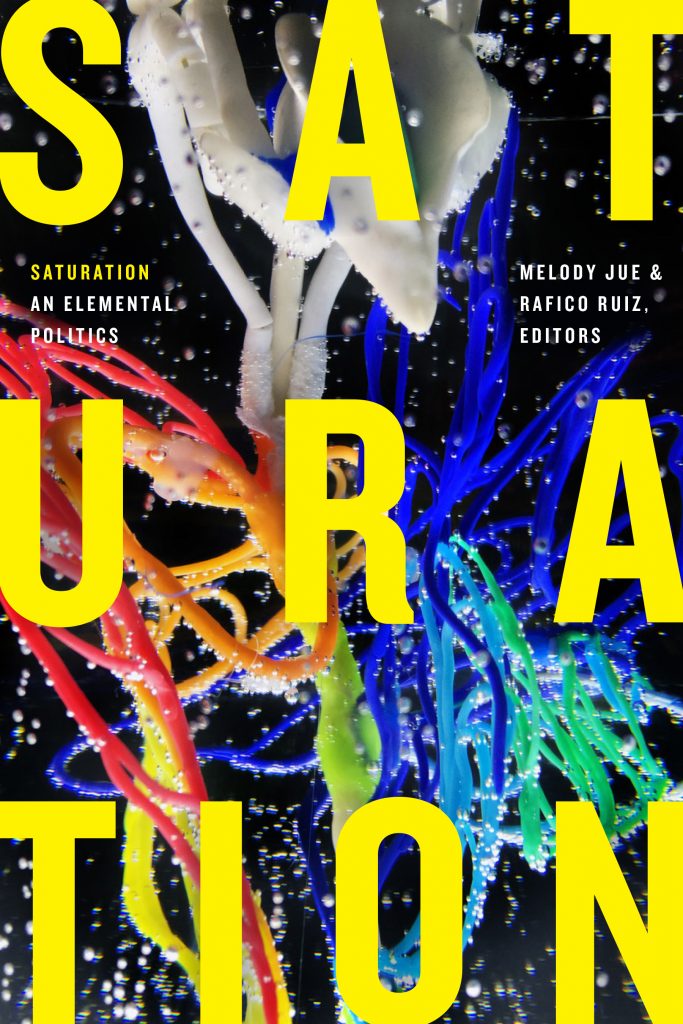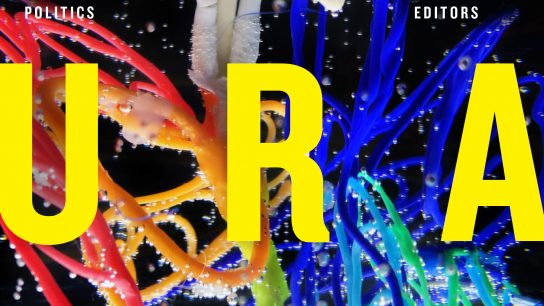Saturation: Interview with Melody Jue and Rafico Ruiz
by
 As part of UCHRI’s investigation into living through upheaval, Alison Annunziata spoke with the co-editors of the collection, Saturation: An Elemental Politics, forthcoming from Duke University Press, to discuss fluidity and non-permanence, language as material, and what a theory of saturation contributes to contemporary discourse on environmental futures. To imagine “a future scholarship that attends to co-present social, ideological, and cultural phenomena that seep into each other,” Saturation: An Elemental Politics thinks through and beyond water, and is organized around three processes of material transformation: thresholds, phase change, and precipitate. Rather than discernible and discrete objects, “saturation,” write Jue and Ruiz, “gravitates to sticky situations where not all agential substances or actors are known in advance.”
As part of UCHRI’s investigation into living through upheaval, Alison Annunziata spoke with the co-editors of the collection, Saturation: An Elemental Politics, forthcoming from Duke University Press, to discuss fluidity and non-permanence, language as material, and what a theory of saturation contributes to contemporary discourse on environmental futures. To imagine “a future scholarship that attends to co-present social, ideological, and cultural phenomena that seep into each other,” Saturation: An Elemental Politics thinks through and beyond water, and is organized around three processes of material transformation: thresholds, phase change, and precipitate. Rather than discernible and discrete objects, “saturation,” write Jue and Ruiz, “gravitates to sticky situations where not all agential substances or actors are known in advance.”
Saturation‘s contributors: Marija Cetinić, Jeff Diamanti, Bishnupriya Ghosh, Lisa Yin Han, Stefan Helmreich, Mél Hogan, Melody Jue, Rahul Mukherjee, Max Ritts, Rafico Ruiz, Bhaskar Sarkar, John Shiga, Avery Slater, Janet Walker, Joanna Zylinska
“By thinking through the heuristic of saturation, this book encourages scholars to contemplate phenomena of vastly different orders under the same umbrella of critical consideration—not to flatten them under the same ontological register, but to hold them in suspension and see how they participate in a situation across local and global scales of relation.”
What oriented you towards saturation as a method and hermeneutic?
MJ: This collection arose in relation to the poetics that emerges from the science of saturation. We are interested in the way that water saturates, but also how saturation gives rise to a different kind of vocabulary that includes not just saturation via its chemical definition. That is part of the thinking–saturation and the chemical imaginary–but then we were also curious about how this term resonates in figurative senses across other ways that people commonly speak about phenomena: we’re all zoom saturated, our attention is saturated. It felt like a natural term to bring together a variety of interests.
RR: It began with water for us. I’m still working on a book called Phase State Earth: Ice at the Ends of Climate Change, which is near completion. And it’s really in that book that I try to think about ice as an environmental medium. Not in the sense of geographically confined to the cryosphere, but also water in its phase changes. And so, I think both Melody and I are really committed to thinking about water as a medium. Saturation really started, in a sense, similar to the blue humanities, which tries to think through the phase states of water, specifically, and how that element is really one that we inhabit bodily, environmentally, and, of course, is one that is increasingly damaged. But our collection gestures beyond water: you can see across thresholds, phase changes, and precipitates.
In Saturation’s introduction, you describe a “material heuristic” that is “post-cartesian” and “volumetric,” that attends to the nonhuman. Is it productive to apply the method of saturation as you lay it out in your work to the non-material, or to the interior world of sentimentality/emotionality?
MJ: In a way, we’re thinking of this as a post-elemental collection, so it appears within the [Duke University Press] series, Elements, but with a tendency to think with the elements there’s already a kind of reification of one’s topic. And it is similar to work on Marxism around commodity histories and using that as a way to trace where things go, and to tell a certain kind of story. So, methodologically, this is part of the reason why Saturation goes beyond water. We’re both on board with Nicole Starosielski in thinking of flow or flux as very abstract and in fact not always connected to water. It doesn’t always specify a material substance or the materiality of what is flowing. You can say data flows, thought flows, just as water flows. There is a lack of specificity. What we are trying to articulate with saturation as a methodology is actually something as simple as starting with a situation, rather than a substance. Saturation is also about learning about co-saturates, or that which is not bounded as an object or an identifiable substance. In a way, it is almost approaching things a bit more like a scientist, someone who is testing or feeling out what is going on in a particular situation. We are trying to make space for things that don’t have a place or cannot take form as intelligibly as work that gravitates towards bounded objects. We are trying to find a term that is adequate for the messiness of certain situations.
RR: What I would add is, as you probably notice across the introduction, qualifiers such as “co-present,” or “co-emergent”: this was necessary in many instances, not to create a sort of jargon, but, through language, to try to account for this process of relational emergence. And, of course, we feel saturated by talk of relationality, generally, and discourses around trying to capture relationality. But I think, as Melody said, being willing to begin with a situation that in some ways cannot be reified precisely through a commitment to tracking it as a co-emergent set of substances is really what saturation as a method is trying to gesture towards. It is certainly intentional because, as we specify in the introduction, we see it as a beginning, as a material heuristic: reading the situation materially, but then being open to the ways in which substances merge and conditions change. In the book’s afterword, Janet Walker describes global warming and climate change as “matter out of phase” (with an intentional echoing of Mary Douglas’ theorization of dirt as “matter out of place”). And I think this is a really great example of how you can attend to this open-ended situation as well as scale down to various situations with precision and analytical acuity around the substances involved. To track across thresholds and phase changes with an anatomical understanding of phenomena through the natural sciences. I think Saturation melds many of these approaches to good effect.
Does rescuing our climate, so to speak, demand a form of “post-cartesian,” “more-than-human” thinking as Saturation sets forth, and, if so, what might that look like? Does the mythic need to be considered alongside the scientific? Is there a way in which Saturation suggests that discourses around climate change and devastation should incorporate both facets?
MJ: This is an interesting observation that unintentionally anticipates an article I was co-writing at the time that we were working on Saturation, which was an essay on Amitav Ghosh’s The Hungry Tide. It is a book that I deeply love teaching, and also brings up questions of the scientific and the “mythic” (or, there are of course people who understandably prefer a different term to that, such as “folkloric,” for example). The Hungry Tide addresses this in a really interesting way through the question of scale. In one passage, an older historian is recalling the way that the river Ganges in folklore fell from the heavens to the earth and was then tangled in locks of hair before flowing out to the ocean. And during that discussion, one character recognizes folklore’s similarity to geology, in that both disciplines describe agents at a certain scale that is beyond the possibility of a human witness, extending over more than one lifetime and also extending over such great spatial scales that there could not possibly be one witness. I thought it was a really compelling moment that also invokes water as something that falls. I discuss this in my other paper, which was in progress at the same time that we were having the saturation conference about water and scale, and orientations of water: how water falls, and then also the way water saturates habitats. These elements are not quite as distinct and what we see as a cartographic boundary. So, in terms of the mythic and the scientific, I think that scale is one place where they really come into conversation in unacknowledged ways. They have that in common: the simulation of a witness when one couldn’t necessarily be there without technically augmented eyes.
RR: I am thinking about the different chapters in Saturation that really address this question squarely. Near the end of the introduction, where we address large-scale fires not as discrete objects, but as containing air, water microbes, sound, and the sort of mass media attention around the fire itself. There is something about the everydayness of those materials that can be read in a more capacious, “mythic,” sense. This register of the cultural through particular media objects is a bit more abstract, but it is actually more in this mundane embodied register where I see it doing work in pointing to objects and situations that are at hand, and saturation lets us see the damage that has been done in a way.
MJ: I think that is a really great point about saturation allowing you to see damage in a different way, much like the way Rob Nixon pitches “slow violence” as a different way of assessing damage. In Saturation, you can especially see it in the ”Precipitate” chapters, such as Lisa Han’s chapter on the necropolitics of sonic seismic testing in the ocean [“Precipitates of the Deep Sea: Seismic Surveys and Sonic Saturation”]. High decibel guns are used to scan the sea floor, and they are deeply disturbing to whales and dolphins who are so acoustically attuned. Han’s chapter looks at whales and dolphins as precipitates; precipitates that literally fall out of the solution of the ocean because of this sonic testing. That is where you can see that saturation provides a different vocabulary for assessing damage in this quite visceral way. Saturation, as well as the precipitate and phase changes are ways of assessing damage in a way that is not about speed or immediate violence, necessarily, but about the violence of different material configurations that often have an anthropogenic link.
How does a theory of saturation hold up within a world trending towards lack, or a world turning away from abundance towards conservation and sustainability?
MJ: I’m reminded of work by Stacy Alaimo, Nicole Seymour, and others thinking about joy and exuberance. I just ordered from Duke University Press this very tempting book, Mapping Abundance for a Planetary Future by Candace Fujikane. It looks at Kanaka Maoli critical settler cartographies of Hawaii. I’m curious to see where she takes us, but this work would be in line, too, with trying to counter narratives of scarcity. I think where the environmentalist movement across different registers has space to grow is really in thinking not just about scarcity politics or austerity politics, but finding other ways of not just identifying but also celebrating and thinking about living within spaces of excess or exuberance. This for me suggests immediate connections to multi-species thinking and other beings that don’t feel exhausted as easily. I think, also, we have a lot to learn from different indigenous epistemologies, especially on this note. I’m thinking of Braiding Sweetgrass by Robin Wall Kimmerer, which is this amazing book that thinks through indigenous science and also botany, using the life experiences of this one scholar. It celebrates gratitude as anti-capitalist because capitalism wants to produce desire, so if you’re grateful for what you have that short circuits the insatiable engine that is fundamental to the way that capitalism works. If you think about it, no one pauses to say what they are grateful for. It is looked at as religious or as a certain kind of ritual. How often does gratitude come up in academia? No one is satisfied; everyone is discontent.
RR: I think Mél Hogan’s chapter [“The Data Center Industrial Complex”], in a sense addresses abundance–at least in its incarnations as a sort of controlled and intentional overabundance produced by the corporate actors of big data. Mél talks about data saturation in a way that aligns with the instrumental creation of surplus data. It is of course a different valence of abundance, one that is certainly more caught within a certain understanding of digital capitalism. But this other register of exuberant, positively affective abundance, I think Saturation falls short of addressing this, as we are often really in this register of critique through situations that are saturated by the aftereffects of over production and consumption.
MJ: Also Bhaskar Sarkar’s chapter on southern saturation [“Media Saturation and Southern Agencies”] looks at the way that the South has been characterized as a space that is always too much, too saturated, and has too many microbes or lifeforms. But he holds back from valuing it, whereas Mél’s chapter is critical of a particular logic of production of excess that is coming from the prison industrial complex and the agriculture industrial complex. So much of sustainability is about disciplining human behavior in different ways at the scale of the individual. If anything, I hope that saturation as method is a little bit undisciplined in a way that stretches out from promoting certain kinds of norms of behavior. While I recognize that this behavior can be very community-minded in a very useful way, I think there is a lot we can do to offer different frameworks that do not center discipline in quite the same way.
There are moments in which saturation is deployed as a weapon, a form of political action, rebellion, or acquiescence. There is often a lyrical agency to the elements that seems undercut by the political. How might the method of saturation respond to its weaponization?
RR: The first thing that comes to mind is a sort of situational environmental damage, or violence, that is actually completely ubiquitous. And I know that, both discursively and materially, microplastics are a part of this. Recent studies around the atmospheric presence of microplastics are much more alarming than people realize. Every breath you take in certain geographic locations is laden with microplastics. And I think that is political in the sense of upholding a particular mode of production and consumption. Again, it is this very mundane, everyday scale where, nonetheless, those effects of environmental violence and damage can be very much political, if we view them through that lens. I think saturation makes that available in a less spectacular fashion.
MJ: I think that is an interesting example of the microplastics because we are always already saturated and often are discovering this after the fact. The condition of living is also a condition of saturation, and I think about this just from having to consider my air pathways as a scuba diver. Tissue saturation is something that occurs just through the way that we breathe. And so some of the politics of air is about the quality of what is saturating us as transcorporeal beings in the first place. I think with the microplastics example, if you think about toxicity, there is something called the body burden. Body burdens are what harmful chemicals you carry throughout your life and measure their accumulation. Scientists might have more precise words for this, but for us, for our purposes, it works with saturation just in thinking about the body, the tissues of the body, as a space that has the capacity for saturation. There is a politics to that, and it is sometimes spectacular and sometimes it’s not. Sometimes it is latent and something you only discover later. The question of how pollution accumulates in the body, this for me is also part of the politics of saturation, even as water itself can be weaponized to do different things. I’m also thinking here of Avery Slater’s chapter [“Fossil Fuels, Fossil Waters: Aquifers, Pipelines, and Indigenous Water Rights”], which looks at indigenous protests against the Dakota Access Pipeline. So, I think we kind of work from this condition of almost originary saturation from the get go, and the collection is trying to point out that this is something that has been ignored. Saturation doesn’t come through later; it is this condition of living. We are in this strange and often jarring condition of having our attention drawn to these saturations that have already happened. Saturation, in this way, offers a different sense of tracking harm from a humanities perspective.
In the background:
Karen Barad, Meeting the Universe Halfway
Marisol de la Cadena, Earth Beings: Ecologies of Practice across Andean Worlds
Hasok Chang, Is Water H2O?
Jeffrey Jerome Cohen and Lyell Duckert, Elemental Ecocriticism: Thinking with Earth, Air, Fire, and Water
Karin Amimoto Ingersoll, Waves of Knowing
Astrida Neimanis, Bodies of Water: Posthuman Feminist Phenomenology
John Durham Peters, The Marvelous Clouds: Towards a Philosophy of Elemental Media
Nicholas Shapiro and Eben Kirksey, “Chemo-Ethnography: An Introduction“
C. Riley Snorton and Hentyle Yapp, Saturation: Race, Art, and the Circulation of Value


